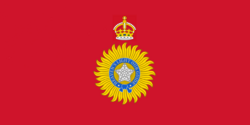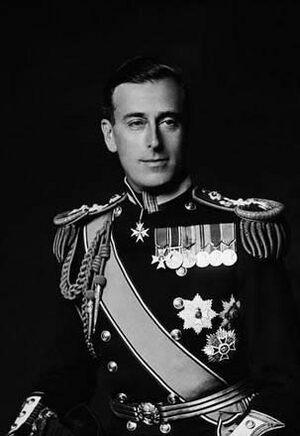| New British Raj | |
|---|---|
| Flag of The New British Raj | |
| General | |
| Official Name | New British Raj |
| Capital | New Delhi |
| Largest City | New Delhi |
| Government | |
| Government Type | Constitutional Monarchy |
| Head of State | King George VII |
| Legislature | Executive Council |
| Head of Government | Viceroy and Governer-General Lord Hastings |
| Judiciary | The Supreme Court |
| Economy | |
| GDP (total) | £5.3 billion |
| GDP (per capita) | £2,700 |
| Currency | Pound Sterling (NBP;£) |
| Demographics | |
| Demonym | British |
| Population | 2,027,005 |
| Official Language(s) | British English |
| Spoken Language(s) | British English, Hindi, Punjabi, |
| Ethnic Groups | White (4%), Asian (95%), Other (1%) |
| Official Religion | Anglican Christian |
| Major Religions | Hindu (70%), Anglican Christian (15%), Muslim (9%), Other (6%) |
The New British Raj is a constituional monarchy in Northern India. The country's territory was held by India before the flood. The state sees itself as the successor to the British Raj and seeks to unify the subcontinent under the crown.
History[edit | edit source]
Before the flood[edit | edit source]
Before the flood, the Royal Family ruled over Great Britain and Northen Island.
The 1911 Contingency[edit | edit source]
In the mid 21st Century, as London was being overrun with refugees and flooding, the Royal Family looked for somewhere to retreat to. In the even of a serious global crisis, there were a number of emergency contingency plans in place which could be activated. Having conevened with their advisors, the reigning monarch at the time, Queen Elizabeth II, enacted 'The 1911 Contingency'. First created by King George V at the 1911 Delhi Durbar, the contingency put into place measures which facilitate an entire move of the royal family and their entourage to New Delhi, India. Although over the following decades the plan was mostly abandoned, the secret buildings, tunnels and caches of supplies remained until they were needed when the contignency was finally enacted.
The interim years[edit | edit source]
Not much is known of the interim years. As India fell to infighting and anarchy, the royal family made their home in New Delhi but remained largely incognito, preferring to bide their time.
The New British Raj forms[edit | edit source]
In 2140 the royal family came out of hiding and established themselves as The New British Raj, with King George II revealed as the new monarch. It is not known how Queen Elizabeth, King Charles or King William passed away. Within a year they had control of the entire city of New Delhi and within half a decade they had pushed west to ensure coastal access.
Geography[edit | edit source]
India's heartland, the Ganges Plain, is gone. The sea's crept up the Brahmaputra valley, too, nearly to the Chinese border. The new breadbaskets are the green Deccan and what's left of the Indus Valley, where the rains have increased. But even the Thar Desert and Pakistan's dry mountains are grasslands, while the Punjab, straddling the old Indo-Pakistan border, is downright lush. The Rann of Kutch is now a great sound; the coastal hills are an island-chain stretching all the way to Bombay, now a modest island town. Calcutta has, of course, been obliterated.
Politics[edit | edit source]
Government[edit | edit source]
The nation is governed by a Constituional Monarchy. The head of state is King George VII, who holds executive authority and great influence over the government. He resides in the royal residence of the former Rashtrapati Bhavan, New Delhi.
Running the state in the name of the Crown is the Viceroy and Governer-General, who is advised by the Executive Council, which is itself formed of 10 elected members including the Viceroy himself. The council operates from the former Secritariat Building, New Delhi.
| Office | Chair |
|---|---|
| Viceroy and Governer General | Lord Hastings GBE |
| Commander in Chief | HRH King George VII |
| Home Affairs | Arthur Maxwell |
| Foreign Affairs | Johnathan Singh |
| Finance and Commerce | Daid Roy |
| Defence | General Sir Robert Hartley-James |
| Civil Defence | Akbar Khan |
| Information and Law | Sir Asaf Singh |
| Logistics | Andrew Cameron |
| Health and Education | Narendra Prasad |
| Labour | Mohammed Noon |
Law and criminal justice[edit | edit source]
The law is based on common-law principles. The essence of common law is that, subject to statute, the law is developed by judges in courts, applying statute, precedent and common sense to the facts before them to give explanatory judgements of the relevant legal principles, which are reported and binding in future similar cases (stare decisis). The courts of provinces are headed by the Senior Courts of major cities, consisting of the Court of Appeal, the High Court of Justice (for civil cases) and the Crown Court (for criminal cases). The Supreme Court is the highest court in the land for both criminal and civil appeal cases in the country, and any decision it makes is binding on every other court in the same jurisdiction.
Foreign Relations[edit | edit source]
At this time the New British Raj does not have any known major foreign relations.
Military[edit | edit source]
The armed forces of the New British Raj - officially, His Majesty's Armed Forces - consist of three professional service branches; The Royal Navy, the Royal Army and the Royal Air Force. The forces are managed by the Ministry of Defence and controlled by the Defence Council, chaired by the Minister for Defence on the Executive Council. The Commander-in-Chief is the reigning monarch, King George VII, to whom members of the forces swear an oath of allegiance. The Armed Forces are charged with protecting the NBR,, promoting its global security interests and supporting any possible international peacekeeping efforts.
Royal Army[edit | edit source]
The Royal Army makes up the majority of the land borne forces and is currently composed of five regiments:
The King's Guard[edit | edit source]
The King's Guard are elite soldiers who can trace their history back to the original Coldstream Guard which followed the Royal Family when they moved to New Delhi in the mid 21st Century. Easily recognized by their distinctive uniform, the Kings Guard are sworn to protect the monarch and his residence with their lives.
1st Royal Delhi Rifles[edit | edit source]
The Royal Delhi Rifles are the largest regiment and make up the bulk of the infantry. Most are recruited from New Delhi and the surrounding area, and all training takes place at The Royal Military Academy in New Delhi.
1st Royal Dragoon Guards[edit | edit source]
The Royal Dragoon Guards make up the motorized and mechanized component of the army. Soldier's are trained to operate Jackal Jeeps and Pangolin Armoured Cars. Their main capability involves forward operations and troop transport.
Royal Tank Regiment[edit | edit source]
The Royal Tank Regiment makes up the armoured component of the army and can trace its history back to the oldest armoured regiment in the world, formed in the old United Kingdom during WW1. Soldiers are trained to operate Leopard Mk I Medium Tanks.
Royal Artillery Regiment[edit | edit source]
The Royal Artilery Regiment consists of large and small field guns as well as towed Anti-Tank and Anti-Air guns. There are also a small number of self propelled AA, AT, field and rocket artillery guns.
Royal Air Force[edit | edit source]
The Royal Air Force manages air operations and currently consists of three wings divided into six squadrons.
Red Wing[edit | edit source]
Red Wing consists of No.1 (F) Squadron RAF, No.2 (F) Squadron RAF, No.7 (F) Squadron RAF and No.8 (F) Squadron RAF. All squadrons take on a fighter role, with pilots flying in Peregrine Mk I fighter planes.
Blue Wing[edit | edit source]
Blue Wing consists of No.3 (B) Squadron RAF and No.4 (B) Squadron RAF. Both squadrons take on a bomber support role, with crews flying Buzzard Mk I bomber planes.
Green Wing[edit | edit source]
Green Wing consists of No.5 (T) Squadron RAF and No.6 (T) Squadron RAF. Both squadrons take on a transport support role, with crews flying Cormorant Transport planes to carry troops and cargo over long distances.
[edit | edit source]
The Royal Navy takes on maritime operations and currently consists of six warships in the Home Fleet.
Battleships[edit | edit source]
The HMS Victory is a King George class battleship, flagship for the First Sea Lors and capital ship for the Royal Navy's Home Fleet. It shares its name with Lord Nelson's flagship from the Battle of Trafalgar in 1805. HMS Victory carries an armanent of over 26 main guns and at wartime carries a complement of 1900 crew.
Light Cruisers[edit | edit source]
HMS Defender
HMS Daring
Destroyers[edit | edit source]
HMS Oxford
Assault Ships[edit | edit source]
HMS Elizabeth
Submarines[edit | edit source]
HMS Vigilant












